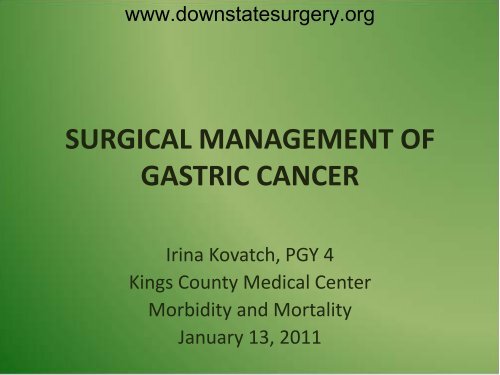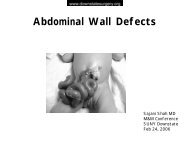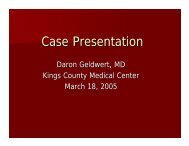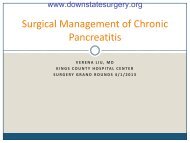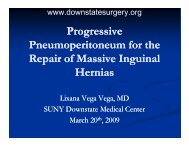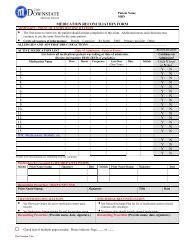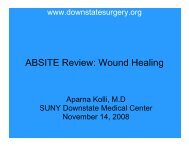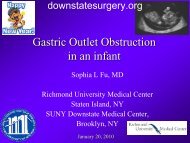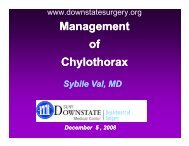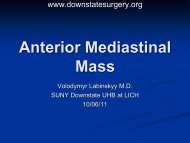surgical management of gastric cancer - Department of Surgery at ...
surgical management of gastric cancer - Department of Surgery at ...
surgical management of gastric cancer - Department of Surgery at ...
Create successful ePaper yourself
Turn your PDF publications into a flip-book with our unique Google optimized e-Paper software.
www.downst<strong>at</strong>esurgery.org<br />
SURGICAL MANAGEMENT OF<br />
GASTRIC CANCER<br />
Irina Kov<strong>at</strong>ch, PGY 4<br />
Kings County Medical Center<br />
Morbidity and Mortality<br />
January 13, 2011
www.downst<strong>at</strong>esurgery.org<br />
Case Present<strong>at</strong>ion<br />
• 60 yo M admitted to medicine on 10/24/2010<br />
with c/o persistent N/V x 3 weeks, weight loss<br />
40lb/1 year<br />
• HPI: diagnosed with <strong>gastric</strong> <strong>cancer</strong> <strong>at</strong> Brookdale in<br />
12/2009, refused surgery<br />
• PMH: GERD, PUD, CKD, PVD<br />
• PSH: LIHR<br />
• Meds: nexium<br />
• SH: denies x3<br />
• FH: <strong>gastric</strong> <strong>cancer</strong> - parent, ovarian <strong>cancer</strong> - sister
www.downst<strong>at</strong>esurgery.org<br />
Physical Exam<br />
• VS: 98.7, 111/77, 96, 16, 100%<br />
• On exam<br />
– cachectic<br />
– bitemporal wasting<br />
– palpable abdominal mass<br />
– umbilical nodule<br />
– guaiac +
www.downst<strong>at</strong>esurgery.org<br />
Labs<br />
• CBC - 6.01/14.2/40.7/423<br />
• BMP - 142/3.1/78/47/44/3.97/112<br />
• LFTs - 7.0/4.0/31/17/59/0.4<br />
• Coags - 10.6/28.2/1.0<br />
• VBG - 7.50/68.9/38.3/49.5/28<br />
• Lipase 120
www.downst<strong>at</strong>esurgery.org<br />
Imaging<br />
• CXR (10/24) - neg<br />
• CT Abd (10/25) - thickening in the <strong>gastric</strong><br />
antrum, limited evalu<strong>at</strong>ion for hem<strong>at</strong>ogenous<br />
metastasis w/o IV contrast, no bulky intraabdominal<br />
LAD<br />
• CT Chest (10/27) - no evidence <strong>of</strong> metast<strong>at</strong>ic<br />
disease, limited w/o IV contrast, nonspecific<br />
lucent lesion within L2 vertibral body<br />
• RUQ US (10/28) - heterogeneous liver
www.downst<strong>at</strong>esurgery.org<br />
CT Abdomen
www.downst<strong>at</strong>esurgery.org<br />
Hospital Course<br />
• Management: NPO, IVF, nexium drip, GI/<strong>Surgery</strong><br />
• EGD (10/28) - copious dark liquid in the stomach,<br />
<strong>at</strong>tempt <strong>at</strong> aspir<strong>at</strong>ion -> vomiting -> p<strong>at</strong>ient<br />
refused NGT -> procedure aborted<br />
• Transferred to surgery, scheduled for OR<br />
• NGT placed - 600cc <strong>of</strong> clear fluid<br />
• Brookdale records<br />
– 11/09 <strong>gastric</strong> biopsy: adenoca w/signet ring cells<br />
– 10/18/10 bone scan: neg
www.downst<strong>at</strong>esurgery.org<br />
Oper<strong>at</strong>ion<br />
• Ex-lap, no gross mets<br />
• Palpable mass in pylorus/antrum<br />
• Enter lesser sac after dividing omentum from<br />
transverse colon<br />
• Stomach mass extending along lesser<br />
curv<strong>at</strong>ure to GE junction<br />
• Mobilized pylorus and 1 st portion <strong>of</strong><br />
duodenum<br />
• Large firm LNs posterior to mid stomach<br />
• Large left <strong>gastric</strong> artery suture lig<strong>at</strong>ed
www.downst<strong>at</strong>esurgery.org<br />
Oper<strong>at</strong>ion<br />
• Mobilized gre<strong>at</strong>er curv<strong>at</strong>ure to splenic hilum,<br />
short <strong>gastric</strong>s preserved<br />
• Transected 1 st portion <strong>of</strong> duodenum and<br />
proximal stomach for subtotal gastrectomy<br />
• Billroth II reconstruction (retrocolic)<br />
• Left 2 JPs (duodenal stump, anastomosis site)<br />
• Excision <strong>of</strong> umbilicus and closure<br />
• EBL 1L, transfusion 2 Units PRBC, 7L crystalloids
www.downst<strong>at</strong>esurgery.org<br />
P<strong>at</strong>hology<br />
• Gastric adenocarcinoma<br />
• Poorly differenti<strong>at</strong>ed<br />
• Some signet ring cells<br />
• Diffuse type<br />
• Tumor invades through serosa (T4)<br />
• 12/17 lymph nodes positive (N2)<br />
• Metastasis in umbilical tissue (M1)<br />
• Stage IV
www.downst<strong>at</strong>esurgery.org<br />
Post-op Course<br />
• POD 0 - SICU intub<strong>at</strong>ed<br />
• POD 1 - extub<strong>at</strong>ed<br />
• POD 2 - transfer to floor, NGT not draining<br />
– Esophagram: intact anastomosis, no leak or<br />
obstruction<br />
• POD 3 - advanced to clears<br />
• POD 4-6 - diet slowly advanced to solids<br />
• POD 6 - JPs removed<br />
• POD 7 - discharged home
www.downst<strong>at</strong>esurgery.org
www.downst<strong>at</strong>esurgery.org<br />
Outp<strong>at</strong>ient Follow-up<br />
• <strong>Surgery</strong><br />
– POD 19: asymptom<strong>at</strong>ic, good appetite,<br />
gained weight, wound healing well, staples<br />
removed<br />
• Oncology<br />
– POD 20: reluctant to receive any chemo,<br />
wants to wait until symptoms for palli<strong>at</strong>ive<br />
chemotherapy
www.downst<strong>at</strong>esurgery.org<br />
Questions
www.downst<strong>at</strong>esurgery.org<br />
Gastric Cancer<br />
• Adenocarcinoma (95%)<br />
• Squamous cell carcinoma<br />
• Adenoacanthoma<br />
• Carcinoid tumors<br />
• GI stromal tumors<br />
• Lymphoma
www.downst<strong>at</strong>esurgery.org<br />
Risk Factors
www.downst<strong>at</strong>esurgery.org<br />
Lauren Classific<strong>at</strong>ion System
www.downst<strong>at</strong>esurgery.org<br />
TNM Classific<strong>at</strong>ion
www.downst<strong>at</strong>esurgery.org<br />
Staging
Clinical Present<strong>at</strong>ion<br />
• Early symptoms<br />
– vague epi<strong>gastric</strong> discomfort, indigestion<br />
• Advanced disease<br />
– weight loss, anorexia, f<strong>at</strong>igue, vomiting<br />
• Physical Exam<br />
– palpable abdominal mass<br />
– Virchow's lymph node<br />
– Sister Mary Joseph's node<br />
– Blummer's shelf<br />
www.downst<strong>at</strong>esurgery.org<br />
– Krukenberg's tumor
www.downst<strong>at</strong>esurgery.org<br />
Preoper<strong>at</strong>ive Evalu<strong>at</strong>ion<br />
• EGD with multiple biopsies<br />
• EUS for staging (some centers)<br />
• Labs<br />
– CBC, BMP, LFTs, Coags<br />
• Imaging<br />
– CXR, CT Abd, CT Chest (proximal tumors)<br />
• Laparoscopy (for T3-T4 tumors) - can identify<br />
unsuspected metast<strong>at</strong>ic disease in 13-57%
www.downst<strong>at</strong>esurgery.org<br />
Surgical Tre<strong>at</strong>ment<br />
• In the absence <strong>of</strong> distant mets: goal - R0 resection<br />
• Proximal tumor – total gastrectomy<br />
– Norwegian Stomach Cancer Trial morbidity and<br />
mortality r<strong>at</strong>es for<br />
• Proximal <strong>gastric</strong> resection - 52% and 16%<br />
• Total gastrectomy - 38% and 8%<br />
• Distal tumor – subtotal or total gastrectomy<br />
– 5-6 cm luminal margin recommended<br />
• Reconstruction: Billroth II or Roux-en-Y
www.downst<strong>at</strong>esurgery.org<br />
Lymph Nodes<br />
• Japanese Classific<strong>at</strong>ion for Gastric Carcinoma<br />
– 16 lymph node st<strong>at</strong>ions or echelons<br />
– st<strong>at</strong>ions classified into groups th<strong>at</strong><br />
correspond to the loc<strong>at</strong>ion <strong>of</strong> the primary<br />
tumor<br />
– presence <strong>of</strong> metastasis to a lymph node<br />
group determines the N classific<strong>at</strong>ion<br />
• metastases to group 1 lymph nodes (and<br />
absence <strong>of</strong> disease in more distant lymph<br />
node groups) is classified as N1
www.downst<strong>at</strong>esurgery.org
www.downst<strong>at</strong>esurgery.org
www.downst<strong>at</strong>esurgery.org<br />
Lymphadenectomy<br />
• D1 resection - removal <strong>of</strong> group 1 lymph nodes<br />
• D2 resection - removal <strong>of</strong> group 1 & 2 lymph nodes<br />
• D3 resection - D2 resection plus removal <strong>of</strong> paraaortic<br />
lymph nodes<br />
• Japanese surgeons perform splenectomy and<br />
partial pancre<strong>at</strong>ectomy during D2 resections<br />
• Western surgeons do not typically resect the<br />
spleen or pancreas because <strong>of</strong> the increased<br />
morbidity<br />
• NCCN guidelines - minimum <strong>of</strong> a D1 resection with<br />
excision <strong>of</strong> <strong>at</strong> least 15 lymph nodes
www.downst<strong>at</strong>esurgery.org<br />
Oper<strong>at</strong>ive Technique<br />
• Avascular plane between the gre<strong>at</strong>er<br />
omentum and transverse colon is incised<br />
• Dissection continues along the avascular<br />
plane between the anterior and posterior<br />
she<strong>at</strong>hs <strong>of</strong> the transverse mesocolon to the<br />
level <strong>of</strong> the pancreas<br />
• L<strong>at</strong>eral <strong>at</strong>tachments <strong>of</strong> the stomach and short<br />
<strong>gastric</strong> vessels are divided
www.downst<strong>at</strong>esurgery.org<br />
Oper<strong>at</strong>ive Technique<br />
• Splenic artery and nodal tissue is dissected<br />
down to the level <strong>of</strong> splenic hilum<br />
• Duodenum is identified and divided<br />
• Nodal dissection proceeds from the porta<br />
hep<strong>at</strong>is toward the celiac axis, left <strong>gastric</strong><br />
artery is divided <strong>at</strong> its origin<br />
• Nodal dissection continues along the right<br />
diaphragm<strong>at</strong>ic crus and esophageal hi<strong>at</strong>us
www.downst<strong>at</strong>esurgery.org
www.downst<strong>at</strong>esurgery.org
www.downst<strong>at</strong>esurgery.org
www.downst<strong>at</strong>esurgery.org
www.downst<strong>at</strong>esurgery.org
www.downst<strong>at</strong>esurgery.org
www.downst<strong>at</strong>esurgery.org
Palli<strong>at</strong>ive Tre<strong>at</strong>ment<br />
• 20 - 30% <strong>of</strong> p<strong>at</strong>ients present with stage IV disease<br />
• Goal - relief <strong>of</strong> symptoms with minimal morbidity<br />
• Surgical palli<strong>at</strong>ion - resection or bypass<br />
• Other techniques<br />
– percutaneous, endoscopic, radiotherapy<br />
• Palli<strong>at</strong>ion <strong>of</strong> bleeding or proximal <strong>gastric</strong><br />
obstruction<br />
– laser recanaliz<strong>at</strong>ion<br />
– endoscopic dil<strong>at</strong>ion<br />
– stent placement<br />
www.downst<strong>at</strong>esurgery.org
www.downst<strong>at</strong>esurgery.org<br />
Outcomes<br />
• Overall 5-year survival 10 - 21%<br />
• 5-year survival for p<strong>at</strong>ients who undergo a<br />
potentially cur<strong>at</strong>ive resection 24 - 57%<br />
• Recurrence r<strong>at</strong>es after gastrectomy 40 - 80% (most<br />
within 3 years)<br />
– locoregional failure r<strong>at</strong>e 38 - 45% (<strong>gastric</strong><br />
remnant <strong>at</strong> the anastomosis, <strong>gastric</strong> bed,<br />
regional nodes)<br />
– peritoneal dissemin<strong>at</strong>ion in 54%<br />
– isol<strong>at</strong>ed distant metastases are uncommon<br />
• Hem<strong>at</strong>ogenous spread occurs to the liver, lung,<br />
and bone
www.downst<strong>at</strong>esurgery.org<br />
Total vs. Subtotal Gastrectomy RCTs<br />
• Ann Surg. 1999 Aug;230(2):170-8. Subtotal versus total<br />
gastrectomy for <strong>gastric</strong> <strong>cancer</strong>: five-year survival r<strong>at</strong>es in a<br />
multicenter randomized Italian trial. Italian Gastrointestinal<br />
Tumor Study Group. Bozzetti F, Marubini E, Bonafanti G, et al<br />
– 618 p<strong>at</strong>ients with distal <strong>gastric</strong> <strong>cancer</strong> underwent TG or<br />
STG with <strong>at</strong> least 6cm margin<br />
• Ann Surg. 1989 Feb;209(2):162-6. Total versus subtotal<br />
gastrectomy for adenocarcinoma <strong>of</strong> the <strong>gastric</strong> antrum. A<br />
French prospective controlled study. Gouzi JL, Huguier M,<br />
Fagniez PL, et al<br />
– 169 p<strong>at</strong>ients with antral <strong>gastric</strong> <strong>cancer</strong> underwent TG or<br />
STG<br />
• Both studies showed no 5-year survival difference
Journal <strong>of</strong> Clinical www.downst<strong>at</strong>esurgery.org<br />
Oncology, Vol 22, No 11, 2004: pp. 2069-2077<br />
Extended Lymph Node Dissection for Gastric Cancer: Who<br />
May Benefit? Final Results <strong>of</strong> the Randomized Dutch<br />
Gastric Cancer Group Trial<br />
H.H. Hartgrink, C.J.H. van de Velde, H. Putter, et al<br />
• Prospective RCT <strong>of</strong> 711 p<strong>at</strong>ients with <strong>gastric</strong><br />
adenocarcinoma who underwent D1 or D2 lymph<br />
node dissection and were followed > 10 years<br />
• Morbidity (25% v 43%; P < 0.001) and mortality<br />
(4% v 10%; P = 0.004) were significantly higher in<br />
the D2 dissection group<br />
• After 11 years there is no overall difference in<br />
survival (30% v 35%; P = .53)
The Lancet Oncology www.downst<strong>at</strong>esurgery.org<br />
- Volume 7, Issue 4 (April 2006)<br />
Nodal dissection for p<strong>at</strong>ients with <strong>gastric</strong> <strong>cancer</strong>: a<br />
randomized controlled trial<br />
Chew-Wun Wu, Chao A Hsiung, Su-Shun Lo, et al<br />
• Single institution trial <strong>of</strong> 335 p<strong>at</strong>ients who<br />
underwent D1 and D3 surgery with median<br />
follow-up <strong>of</strong> 94.5 months<br />
• Overall 5-year survival was in D3 group compared<br />
to D1 group was 59.5% vs 53.6% (difference<br />
between groups 5.9%, log-rank p=0.041)<br />
• P<strong>at</strong>ients who had R0 resection had recurrence <strong>at</strong><br />
5 years <strong>of</strong> 50.6% for D1 surgery and 40.3% for D3<br />
surgery, results not st<strong>at</strong>istically significant
www.downst<strong>at</strong>esurgery.org<br />
N<strong>at</strong>ional Comprehensive Cancer Network<br />
Practice Guidelines in Oncology – v. 2.2010<br />
Principles <strong>of</strong> Gastric Cancer <strong>Surgery</strong><br />
• Tis-T1a tumors: candid<strong>at</strong>es for endoscopic resection<br />
• T1b-T3: distal, subtotal or total gastrectomy to achieve<br />
R0 resection (typically >= 4cm from gross tumor)<br />
• T4 tumors: en bloc resection <strong>of</strong> involved structures<br />
• Gastric resection should include the regional<br />
lymph<strong>at</strong>ics – peri<strong>gastric</strong> (D1) and those along the<br />
named vessels <strong>of</strong> the celiac axis (D2), with a goal <strong>of</strong><br />
examining >= 15 nodes<br />
• Routine or prophylactic splenectomy is not required
www.downst<strong>at</strong>esurgery.org<br />
N<strong>at</strong>ional Comprehensive Cancer Network<br />
Practice Guidelines in Oncology – v. 2.2010<br />
Principles <strong>of</strong> Gastric Cancer <strong>Surgery</strong><br />
• Criteria for unresectability for cure:<br />
– Locoregionally advanced<br />
– Distant metastases or peritoneal seeding<br />
• Unresectable tumors:<br />
– Palli<strong>at</strong>ive resection should not be performed<br />
unless p<strong>at</strong>ient is symptom<strong>at</strong>ic<br />
– Lymph node dissection is not required<br />
– Gastric bypass with gastrojejunostomy may be<br />
useful in palli<strong>at</strong>ing obstructive symptoms


